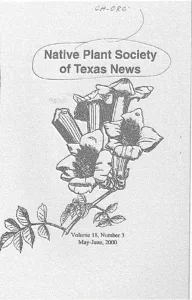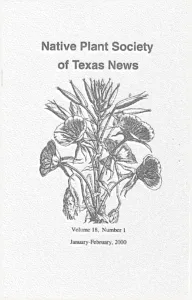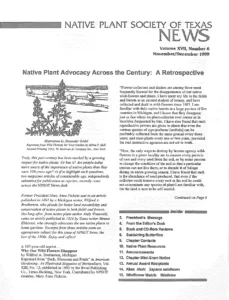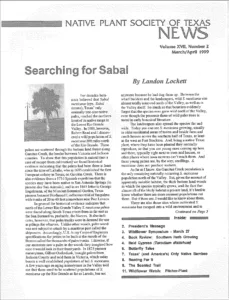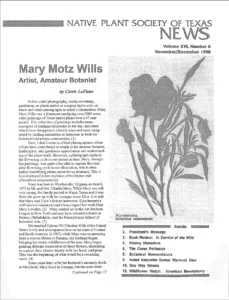Latest Issues

Fall 2025 Member Magazine
President’s Message | Executive Update | Celebrating Leadership | Curb Appeal with a Cause | Grant Recipients | Autumn’s Perfect Pairing | Native Plant Database | Sustainable Landscaping | Winterizing Tips

Summer 2025 Member Magazine
Executive Summary | Resilience in Bloom | Suburban Sanctuary | Texas-tough Summer Survivors | Where Salsa Meets Sage | A Rain Garden Grows | Member News | Smart Watering

Spring 2025 Member Magazine
Executive Summary | Blooming with Possibility | Wildflower Waltz | Native Grasses | Member News | Texas Wildflower Day
Distribution
- Texas Native Plants is published quarterly and the digital version is distributed free to all Society members in current standing.
- The digital version is also available in our library below.
- Print versions are mailed at no cost to Society members in current standing who select to receive a print copy when they join/renew.
- Libraries, educational institutions and other organizations may qualify to receive the publication for a $5 annual fee.
- Contact the membership coordinator.
- Many of our chapters publish their own newsletters and websites.
- These have their own deadlines and guidelines. See list of chapters.
History
Since its founding the Society has provided a news periodical to its members. there have been a variety of names and formats. The Texas Wildfower Newsletter edited by Carroll Abbott served as the first newsletter. He advocated the formation of the Native Plant Society of Texas in his quarterly publication Texas Wildflower Newsletter. After the Society was created in 1980, a free subscription to Abbott’s newsletter was provided as a benefit to all members. His declining health eventually prompted Abbott to request that the Society start its own newsletter. Lean more about the Carroll Abbott story.
Beginning in 1983 our own official publication has documented the evolution of the native plant movement and the Native Plant Society of Texas. The publication has had several slightly different names and formats over the years. By 2005 it had evolved into a full-color glossy magazine.
Editorial Submissions
The Native Plant Society of Texas encourages submission of articles, photos, pertinent news or other interesting information for publication.
- Submit articles or written items as email attachments.
- Send photos as email attachments in JPG, RAW or TIFF format.
- Larger file size and best quality are preferable.
- Contact the Editor for more information.
We reserve the right to edit all submissions for accuracy, relevance, length, grammar or for other reason. In matters of style our print publication generally follows the Chicago Manual of Style.
Unless prior arrangements with the editor are made, submissions may also appear on our website and linked on our social media pages. We do not accept outside advertising in any of our publications.
Publications Library
Click below to view issues by year/editor. Or visit our online archive.
2001 – Sep/Oct
- Lobelia cardinalis, Quercus virginiana
- Dormancy
- Don’t Give Up On Oaks!
2001 – Jul/Aug
- Eupatorium rugosum
- Landscape Maintenance Tips
2001 – May/June
- Alophia drummondii, Sambucus canadensis
- Snakes In Our Midst
- Mother Nature/Restoration Partner
2001 – Mar/Apr
- An Outside Curriculum
- Oh Deer
- Chile pequin
2001 – Jan/Feb
- Landscape Restoration
- Plants You Can “Bank” On
- Dr. Geoffrey Stanford Memorial
- Spring Field Trip: East Texas
- Gelsemium sempervirens
2000 – Nov/Dec
- Perspective: Drought & Native Plant Communities
- Treasure of the Blackland Prairie
- Lawn Invaders
- Tribe Focus: Cacteae echinocactinae
2000 – Sep/Oct
- Of Brasil, Berries & Birds
- Juniperus ashei, Marsilea macropoda
- Collecting Native Seeds
- A Texas Native By Any Other Name
2000 – Jul/Aug
- Vegetational Areas of North Central TX
- Of Passion-flowers & Cultivars
2000 – May/June
- Re-discovering the Cross Timbers
- A Moonlit Garden
2000 – Mar/Apr
- Yuccas, Detergent & Other Things
- Confessions of a Native Plant Lover
- Pretty Poison: Datura sp.
2000 – Jan/Feb
- Texas Native Trees Web-site
- Sumacs of Texas
- Brother Daniel Lynch Garden
1999 – Nov/Dec
- Retrospective: Native Plant Advocacy
- Sustaining Butterflies on the Range
- Alien Alert: Sapium sebiferum
- Phoradendron tomentosum
1999 – Sep/Oct
- Rare Plants of Lower Rio Grande Valley
- Propagating Native Grape Vines
- Mimosa wherryana, Avicennia germinans, Baccharis halimifolia
- Alien Alert: Arundo donax
1999 July/Aug
- Protected Habitat: Rio Grande Delta
- Helietta parvifolia, Amyris madrensis, Passiflora incarnata
- Alien Alert: Cenchrus ciliaris
1999 – May/June
- Plant Conservation: Hibiscus dasycalyx
- Marie Wesby Memorial
- Coreopsis nuecensoides, Drosera brevifolia
- Alien Alert: Salvinia molesta
1999 – Mar/Apr
- Searching for Sabal mexicana
- Taxodium distichum, Arundinaria gigantea
- Thamnosma sp., Sarracenia alata
1999 – Jan/Feb
- Environmental Restoration
- Ephedra antisyphilitica, Erigeron philadelphicus
- Landscape Use of Native Shrubs
- Seeds of Texas Seed Exchange
1998 – Nov/Dec
- Profile: Mary Motz Wills
- Menodora longiflora, Callicarpa americana
- Botanical Nomenclature
- Barton Warnock Memorial
- One Way Streets
- By the Light of the Moon
1998 – Sep/Oct
- Myths of Landscaping
- Letters in response: Hesperaloe parviflora
- Research: Oak Wilt & Wound Painting
- Taxodium mucronatum, Helianthus annuus
1998 – July/Aug
- Hesperaloe parviflora, Ziziphus obtusifolia, Gaillardia pulchella
- Oak Wilt & Wound Painting
- Research: Native Grapes at Texas Tech
- Palo Duro Canyon










